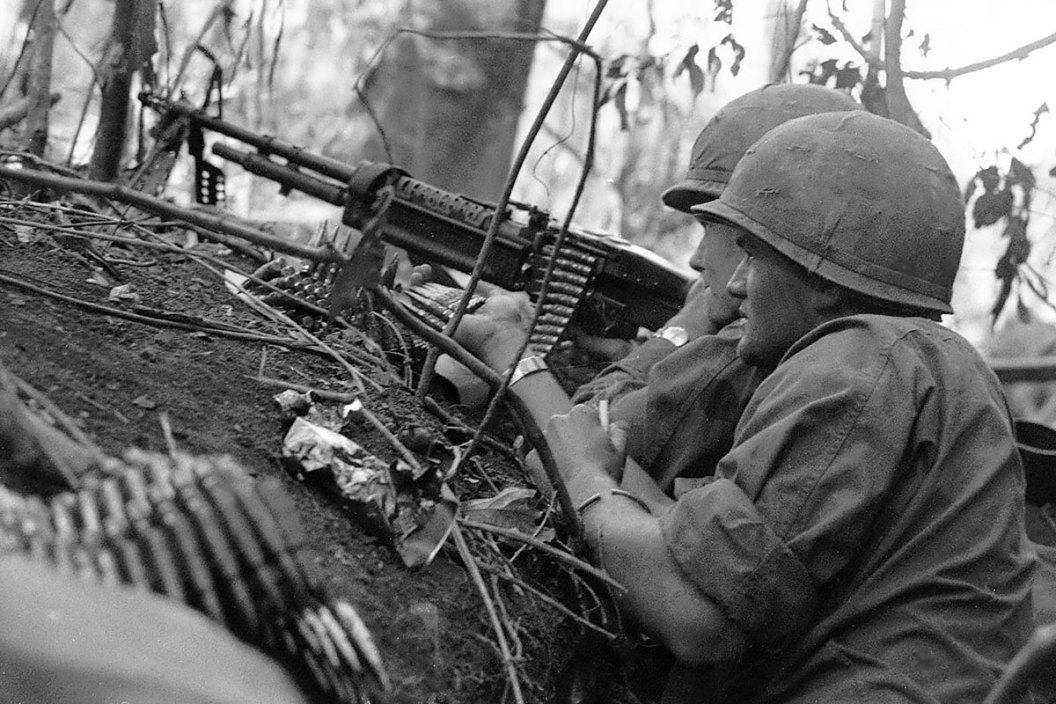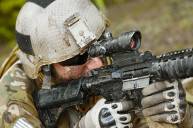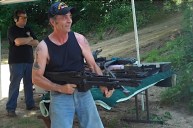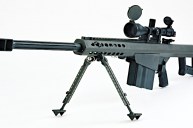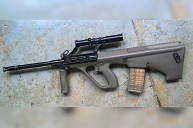The small arms from this polarizing conflict included a lot of firsts, and a few screw-ups. Here's a look at the guns of the Vietnam War.
The Vietnam War saw a lot of firsts in terms of equipment and tactics.
On the American side, helicopters offered a new and effective way to quickly insert troops into dense jungles as well as extract them, allowing a force to mass in a location that would otherwise be unreachable by just about anything other than men on foot.
On the ground, the firearms that troops were being issued in the field were pretty much brand new, and much different than what United States soldiers had fought with in the Korean War, which was almost entirely World War II surplus.
The way they were used was also different. In a war of attrition, the ability to bring superior firepower was everything, especially for infantrymen operating in small groups with their only avenue of retreat being a helicopter. If a they encountered an inferior force, superior firepower would ensure they could overcome the enemy. If they encountered a superior force, having more firepower meant they could hopefully suppress the enemy force long enough to be extracted.
Accuracy at distance was no longer as important as being able to pour on huge volumes of firepower through dense jungle.
Here's a look at what was being used in this conflict.
U.S. Small Arms
Rifles
The iconic M16 rifle, which remains in service today, was introduced early on during the Vietnam War. The story of how the M16 came to be is a bit complicated. The United States began the 1960s believing the M14, a reworked 7.62 NATO version of the M1 Garand, would be the new general issue service rifle.
As the war in Southeast Asia was ramped up, supply issues with the M14 and other problems meant that there simply wouldn't be enough of them to issue to all the troops that would need a rifle.
The only other rifle in the pipeline was Armalite's AR-15, which had previously been ordered in a small quantity by the Air Force to replace their aging M1 Carbines. A couple thousand were also issued to U.S.-backed South Vietnamese troops in lieu of the World War II weapons they'd previously been given.
All reports from the field were excellent, so the Department of Defense decided the AR-15 was the way to go.
There was resistance to change, of course. The M16 was a bizarre firearm when compared to the M1 Garand and the Springfield '03 before it—a modular amalgamation of aluminum and polymer at a time when plastic was synonymous with cheap, fragile, and disposable. Plus, it fired a tiny, new projectile.
In actuality, only some Air Force personnel were ever issued true, original M16 rifles, just like the ones that were earlier sent to U.S. advisers and allies in South Vietnam. The first batch of guns delivered to the U.S. Army infantrymen were actually XME16E1 rifles. The Army required that the rifle include a forward assist so the bolt could be forced into battery (whether or not it was necessary is a debate for another time).
Later, the M16A1 was widely issued to U.S. armed forces, which included a birdcage flash suppressor replacing the three-pronged style, fencing on the receiver around the magazine release button, the forward assist with a round plunger instead of the tear drop style, a brass deflector, and a T-shaped charging handle. The chamber and bore were also chromed, and many XME16E1 rifles were eventually chromed as well, to help reduce fouling.
The M16 was initially issued with 20-round magazines, as the 30-round mags proved to be unreliable. Closer to the end of the war, 30-round mags began to find their way to troops, but they were often only loaded with 28 or 27 rounds to avoid feeding issues. The 20-round magazines were often taped together "jungle style" so a rifle could be reloaded quickly by flipping the mags around.
When it was first introduced, the Army made ammunition for the M16 with a completely different type of propellant than had ever been used in the rifle, some internals were not chromed when they should have been, and astonishingly, the Army told troops that the rifle never had to be cleaned, and didn't even issue cleaning kits for the gun.
This resulted in some horrible incidents involving soldiers' guns jamming in firefights and unfortunately getting them killed. The rifle was tweaked a little, cleaning kits were issued along with detailed instructions, and, eventually, better ammo was issued as well.
The M16 was also the first service rifle issued by the U.S. military that could fire in full auto. The idea was that it could be used as a rifle when needed, and could also serve the function of a submachine gun. Its efficacy in full auto with 20-round magazines was debated and troops were encouraged to fire in bursts. In fact, some later iterations of the M16 included a 3-round burst setting in place of a full-auto mode to force ammo conservation.
M60 Machine Gun
When it came to heavy machine guns used in Vietnam, they largely were guns still in use since World War II, like the M2 Browning and its various configurations. But there was a new machine gun being carried at the squad level: the M60, otherwise known as "The Pig."
The M60 machine gun was not exactly a beloved weapon. When it worked, it worked really well and fired 7.62 NATO ammo from a disintegrating-link belt and an open bolt at 550 rounds per minute. It was light enough to be rapidly moved and positioned to deliver concentrated fire, and could also be fired on the move, from the hip. The idea was to provide a squad machine gun that could be used like the BAR, but that was lighter, shorter, and not limited by box magazines.
Its design was heavily based on the German FG 42 and MG 42. The feed mechanism and top cover are visually very similar even to the casual observer. The M60 also incorporated features from the M1941 Johnson LMG.
In addition to being a squad-level machine gun, it was also used as a mounted machine gun on ground vehicles and in the iconic Huey helicopters, the nickname for the Bell UH-1 Iroquois chopper.
Like I said, when it worked it worked, but as for the goal of building a "light" machine gun, the M60 failed spectacularly. It weighed at a hefty 24 pounds, while the BAR weighed about 16 pounds, and the FG 42 from WWII weighed about 11 pounds. So hauling that thing through the jungle wasn't easy, but it also required spare barrels so the gun could stay up when its barrels overheated. Oh, and you had to carry the ammunition, too.
With platoons often operating in the jungle with the only supply lines being what could be flown in on choppers, all that equipment had to be hauled. Usually, every member of a squad would carry at least a belt of ammo to keep the M60 fed.
It also had some design flaws. The fire control mechanism was held in place by a single, small spring, which could be broken if jarred hard enough...leaving the essential component on the jungle floor, and the M60 a useless hunk of steel. The gas system was held in place by a single nut, which was known to walk off under recoil. Troops would often solve this problem by wiring the nut in place, which, in turn, made barrel changes slow and clumsy.
Handguns
When it came to handguns, there was actually a wide variety issued to various U.S. military personnel. The standard handgun of U.S. and ARVN troops was the Colt M1911A1 carried by U.S. forces in WWI, WWII ,and Korea.
A shorter version of the 1911, the Colt Commander, was issued to officers, who were also issued Colt Model 1903 Pocket Hammerless pistols early in the war. U.S. Air Force pilots were issued Colt Detective Special .38 Spl revolvers, which were also used by tunnel rats. Tunnel rats also used M1917 revolvers and Smith & Wesson Model 10s, which were also more generally issued early in the war.
Grenade Launchers
One of the most effective new weapons of the Vietnam War was the M79 grenade launcher. This break action single shot weapon had an aluminum tube barrel and a wooden stock. It fired the new 40x46mm grenade, which used the "high-low propulsion system" which resulted in low felt recoil and a range of about 400 yards.
Its distinctive sound earned it a number of nicknames, including "Thumper and "Bloop Tube."
There were a variety of 40mm rounds available, including high explosive, anti-personnel, smoke, buckshot, flechette, and flares. By the end of the war, the M203 grenade launcher was developed. It used the same ammo, but was attached under the barrel of an M16, allowing a grenadier to also serve as a rifleman.
Sniper Rifles
Snipers in Vietnam didn't have a whole lot of options when it came to precision rifles. Some USMC snipers used M1903A4 Springfield rifles early in the war before it was replaced by the M40, built on the Remington Model 700 bolt gun. The M40 also replaced the USMC's Winchester Model 70 rifle. The U.S. Army began issued the M21 Sniper Weapon System, which was the sniper variant of the semi-auto M14.
Shotguns
At the outset of the Vietnam War, 12 gauge shotguns leftover from World War II were issued to some troops. Most jungle engagements were at fairly close distances, and shotguns proved to be extremely useful in close-quarters conflicts.
Winchester Model 12 and Stevens M520-30 pump action trench guns were refurbished as necessary and sent to Vietnam, along with a quantity of Winchester Model 97 shotguns. When the supply of surplus shotguns was exhausted, a succession of contracts were issued to Ithaca Gun Co. for a plain riot version of the popular bottom-ejecting Model 37 pump gun. The lack of an ejection port on the side helped the shotgun stand up against the dirt and muck of Vietnam.
Various Other Weapons
Special forces personnel were issued and were allowed to carry a much wider variety of weapons, including the Colt Commander, Browning Hi-Power pistol, Ingram MAC-10 submachine guns, Colt Python revolvers, S&W Model 27 revolvers, and the suppressed S&W Mark 22 Mod 0 "Hush Puppy" pistol.
Special Forces troops, including the newly established MACVSOG group, used a lot of weapons that regular U.S. troops never saw and included personnel from the U.S. Army Special Forces, the U.S. Navy SEALs, and the U.S. Air Force, as well as the CIA and elements of the U.S. Marine Corps.
U.S. troops were typically issued the M18 and M18A1 claymore anti-personnel mine, which could be detonated manually with a wired detonator or vie a trip wire. The mine held layers of steel ball bearings serving as shrapnel and C4 explosive.
Guns of the North Vietnamese Army and Viet Cong
All kinds of WWII era weapons from a variety of countries were used by NVA and Viet Cong forces during the war, including rifles, machine guns, bombs, mines, and everything in between.
The most well equipped North Vietnamese Army soldiers were usually armed with Soviet Union weapons made available via China, like AK-47 assault rifles. These were heavier than the M16 and had a slower rate of fire, but they fired a more powerful cartridge from 30-round magazines and could remain functioning with very little maintenance.
Conversely, Viet Cong troops were typically armed with older SKS rifles and maybe a grenade or two if they were lucky, or whatever weapons they were able to scrounge or capture.
Viet Cong forces also relied on a wide variety of difficult-to-spot booby traps both on trails and in their tunnel systems. Sometimes they use sharpened stakes or even poisonous snakes as their lethal component. Other times, they used captured U.S. ordnance. A grenade with the pin removed and stuffed in a tin can and attached to a tripwire was effective and impossibly simple to make.
Al in all, the Vietnam War brought plenty of never-before-used weapons to our troops, and for all its brutality and strife, marked a turning point in conflict weaponry for the entire world.
NEXT: TAKE A LOOK AT BRITAIN'S SEMI-AUTOMATIC RIFLE OF WORLD WAR ONE, THE FARQUHAR-HILL
WATCH
